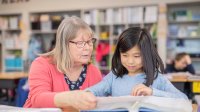The Secret to Creating Effective Community Partnerships
A former elementary school principal describes how her school integrated community volunteers to enhance students’ academic growth.
Your content has been saved!
Go to My Saved Content.Schools across the country face a conundrum: We want to engage all learners and meet a variety of student needs, but teachers are strapped for time within the instructional day. One way to support the growing needs of all students is through the strategic use of volunteers and community members.
As a principal at Madison County Elementary School, I often had community members who were interested in volunteering at the school. Initially, we struggled with ways to utilize these volunteers in a meaningful way where the students’ academic growth could be measured. However, we found ways to build partnerships with community organizations that have been in place since 2018.
Here are three ways we have integrated community members into our school to help enhance academic growth.
Reading
My first successful experience with community volunteers began with meeting Frank, a 90-year-old retired NASA engineer. Frank was convinced that conquering student literacy in the primary grades was the key to changing the school-to-prison pipeline. He showed me a PowerPoint presentation he had developed that outlined how prison capacities are built based on the number of students with below-grade-level reading results in the third grade. Frank was passionate about changing this trajectory for students and proposed the use of the Arise2Read program as the way to accomplish this goal.
Arise2Read is a sight-word, game-based intervention program. Students were assessed initially on the Frye high-frequency word list. Each child’s list was tailored to the sight words that they had not mastered. Volunteers were background-checked and then selected times to meet with individual students to play games that utilized the sight words. The volunteers felt comfortable with this task, since the games are familiar and easy to play.
Each child received sight-word support at least three times each week. Sometimes they worked with different volunteers based on their availability for the week; however, it was easy for each volunteer to pick up where the last session ended by keeping materials organized in bins. As the students mastered new words, they progressed to the next five words on their list. Upon completion of the school year, every child who participated in the Arise2Read intervention made significant gains based on their DIBELS early literacy assessment.
Arts
Other community partners have focused on ways to increase arts exposure and student engagement strategies. Arts funding is declining in many places around the country. In Alabama, elementary-aged students receive art and music instruction only one time weekly for one semester each school year. My school began partnering with the North Alabama Arts Education Collaborative (NAAEC) in 2019 as a way to expose more students to the arts. Since the arts are an area where many of our harder-to-reach students thrive, the NAAEC and I discussed ways that we could integrate the arts into core content areas such as reading, science, and mathematics.
Our partnership began with the development of an instructional unit based on the study of sound waves. Students learned about the science content from their teacher. Then Pat Nickel, an artist-in-residence, taught the students how to build and play cigar box guitars. The students learned through experience how the different pitches were developed using the cigar box guitar strings. Through learning simple chords and strumming techniques, they were able to perform a few songs on their newly created instruments.
Student engagement was through the roof during this project. The students were excited to learn about the science content as they saw and heard it come to life during the culminating project. Interest in arts integration snowballed as classroom teachers saw the excitement that came from the students and their colleagues during this unit. Our teachers quickly developed arts integration units that incorporated theater and drama into the development and study of character traits in language arts, as well as the development of a dance unit with a local ballet artist while the students were learning about joints and the human body.
Civics and Character Education
Other community partnerships have provided more immersive events that facilitate the development of civics and character traits within students. The Liberty Learning Foundation is a nonprofit group that teaches students about the history of the Statue of Liberty through a highly engaging assembly that provides students with a frame of reference for the size and importance of our nation’s iconic monument. Students learn lessons about American history, civics, financial literacy, character, and career readiness during this 10-week unit. Teachers are assigned a partner from the foundation who guides them through the lessons over the course of the unit.
As a culmination, students nominate someone who has exhibited these traits as a “super citizen” within their community. Some of the award winners from the past have been school bus drivers and even a young peer who had been raising funds for cancer patients at St. Jude. This person is invited to the final assembly, where they are awarded a small Statue of Liberty memento as a thank-you for the impact that they have made on the community.
Each of these community partnerships has served as enriching educational experiences for students within my school. I cannot urge colleagues enough to welcome partnerships between organizations and individuals in your community so that you can increase student engagement and academic achievement. As an administrator, I wanted to ensure that these relationships would not take away from the standards-based instruction that is required for each grade level.
These partnerships are aligned with or enhance the mandatory standards-based instruction. I am always on the lookout for partnerships that can enhance the quality of the academic programming provided at my school. This way, you can encourage students to say “Howdy, partner!” to the caring adults within their community.
